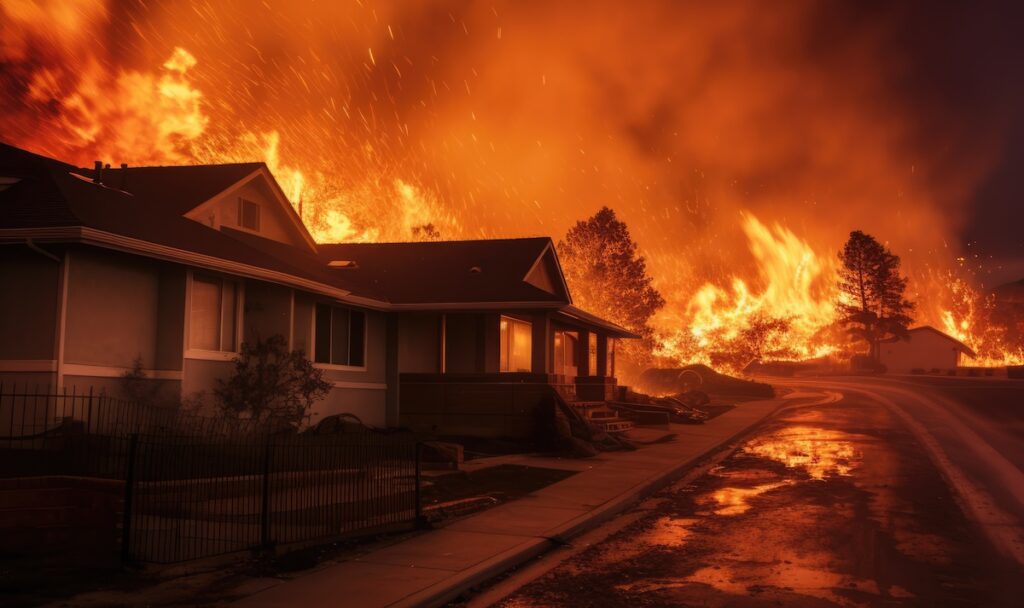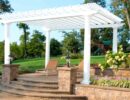Protect yourself from contractor scams after a disaster or fire like the Los Angeles area fires. This guide provides essential tips for vetting contractors, recognizing red flags, and making sure your home is restored properly.
The recent fires in Los Angeles have left thousands of homes destroyed or damaged by fire, smoke, and ash, creating a surge in demand for repair and restoration services. Unfortunately, this situation can—and usually does—attract unscrupulous or fly-by-night contractors looking to take advantage of vulnerable homeowners.
For most families, their home represents their largest investment, making its proper restoration or replacement after a disaster paramount. It’s crucial to be extra vigilant during this time, to protect yourself from scams, and to make sure your home is restored correctly.
The Challenges of Post-Fire Restoration
Beyond the flames, smoke and ash pose significant health risks, containing microscopic particles and toxins that can linger long after the fire is extinguished, according to the Environmental Protection Agency (EPA).
During fires, smoke and soot can permeate every corner of your home, affecting walls, furniture, the HVAC system, and more.
Ash and Debris Removal
Sweeping and using leaf blowers are strongly discouraged for ash and soot removal after a fire because they spread fine, potentially hazardous particles, worsening the situation. These particles, easily dispersed into the air, can increase indoor air pollution, causing respiratory problems and contaminating previously unaffected areas. Additionally, ash can be abrasive, scratching delicate surfaces like wood and glass. Soot, often acidic, can become corrosive when mixed with moisture, further damaging materials and driving smoky odors deeper into fabrics and porous surfaces.
Instead of these methods, professional fire restoration companies use specialized techniques like HEPA vacuuming, chemical sponges, and professional HVAC cleaning to effectively and safely remove ash and soot without causing further damage or health hazards. Workers involved in ash removal need to wear protective gear, including respirators, gloves, and protective clothing, to avoid inhaling or coming into contact with hazardous materials.
Structural Damage Repairs
It goes without saying that fire can compromise the structural integrity of a building, requiring extensive repairs or even rebuilding. In most cases, this is not DIY work. A structural engineer or qualified contractor needs to assess the damage to determine the extent of repairs needed. This may involve inspecting load-bearing walls, foundations, roofs, and framing.
Repairs can range from replacing damaged framing members to rebuilding entire sections of the structure. This often requires permits and inspections to ensure the work meets building codes.
Types of Companies That Can Help
Several types of companies handle these tasks, and often a single company will provide both services:
- Fire damage restoration companies: These companies specialize in all aspects of fire damage restoration, including ash and debris removal, smoke and odor removal, structural repairs, and often contents restoration. They are your best bet for comprehensive service.
- General contractors: While some general contractors may have experience with fire damage repair, it’s crucial to choose one with specific expertise in this area. More about this below.
- Specialty cleaning companies: Some companies specialize in cleaning services like soot and odor removal, which can be useful if the damage is primarily smoke-related.
How to Find These Companies
Finding reputable fire damage restoration companies requires careful research. A good first step is contacting your insurance company. They frequently maintain a list of preferred vendors—restoration companies they’ve vetted and trust to handle claims efficiently. While using a preferred vendor can streamline the insurance process, you’re not obligated to choose from their list.
Independently researching companies is always recommended. Online searches using terms like “fire damage restoration [your city]” or “fire damage repair [your city]” will yield local results.
Be sure to scrutinize online reviews on platforms like Google, Yelp, and the Better Business Bureau (BBB) website—all of these offer ratings and user reviews.
Local builder or contractor associations can also be valuable resources, as they often have member directories of qualified and reputable businesses in your area. These associations often have vetting processes for their members, giving you added assurance. Remember to check for licensing and insurance information with your state’s contractor licensing board.
Important note: When hiring any contractor for fire damage restoration, it is crucial to verify their licenses, insurance, and experience. Get multiple estimates and make sure everything is documented in a detailed contract.
Red Flags to Watch For
Beware of the following:
- Door-to-door solicitors. Be extremely cautious of contractors who go door-to-door offering their services. Reputable companies rarely solicit business this way.
- Pressure tactics and “limited-time offers.” Scammers often use high-pressure tactics, claiming they have limited availability or that prices will soon increase. Don’t fall for these tricks.
- Requests for large upfront payments. Avoid contractors who demand large deposits before work begins. A reasonable down payment is acceptable, but never pay the full amount upfront.
- Vague contracts or verbal agreements. Ensure everything is in writing, including a detailed scope of work, materials to be used, a payment schedule, and a clear timeline.
- Out-of-state contractors with no local presence. While some reputable out-of-state companies may come to assist after a disaster, be wary of those with no local office or references.
- Offers to handle insurance claims directly. While some contractors can assist with insurance paperwork, be cautious of those who offer to handle the entire claims process for you. This could be a sign of fraud.
Protecting Yourself: A Step-by-Step Guide
Here are the procedures to follow for best results:
- Contact your insurance company first. Before contacting any contractors, contact your insurance company to file a claim and understand your coverage.
- Get multiple estimates. Obtain written estimates from at least three reputable contractors. Compare the scope of work, materials, and pricing.
- Verify licenses and insurance. Check the contractor’s license with the California State License Board (CSLB) and verify their liability insurance and worker’s compensation coverage.
- Check for local references and reviews. Ask for references from past clients in the Los Angeles area and check online reviews on sites like Yelp, Google, and the Better Business Bureau.
- Get everything in writing. Ensure the contract includes:
- Detailed scope of work
- Materials to be used
- Payment schedule tied to completion milestones
- Project timeline
- Warranty information
- Don’t pay in full until the job is complete and inspected. Withhold final payment until you are completely satisfied with the work and it has passed any necessary inspections.
- Be wary of “public adjusters” who solicit business. While licensed public adjusters exist, be cautious of those who solicit business immediately after a disaster. Verify their credentials with the California Department of Insurance.
Specific Considerations for Fire Damage
Here are indicators of a contractor’s expertise in smoke, soot, and odor removal after a fire:
Indicators of Expertise in Smoke and Soot Removal
Specific experience. Don’t just ask if they’ve done it; ask how much they’ve done. Look for contractors who specifically advertise fire and smoke damage restoration as a core service, not just a sideline. Ask about the number of similar projects they’ve completed.
Cleaning techniques. Inquire about the specific cleaning methods they use. Look for mentions of:
- HEPA vacuuming: This is crucial for removing microscopic particles.
- Dry cleaning sponges: These are specialized sponges designed to absorb soot without smearing.
- Chemical cleaning agents: Professionals use specific cleaning agents formulated for different types of soot and surfaces. Avoid contractors who suggest using household cleaners.
- Content cleaning: Ask how they handle cleaning of contents like furniture, clothing, and personal belongings affected by smoke and soot.
Equipment. Professional restoration companies use specialized equipment, including:
- HEPA vacuums: As mentioned above.
- Air scrubbers: These machines filter out airborne particles and odors.
- Thermal foggers: These disperse a deodorizing fog that neutralizes smoke odors.
- Ozone generators (use with caution): While effective for odor removal, ozone can be harmful to health and materials if used improperly. Be sure the contractor uses them safely and according to industry best practices.
Certifications. Look for certifications from organizations like the Institute of Inspection, Cleaning and Restoration Certification (IICRC). The IICRC offers certifications in fire and smoke restoration.
Understanding of different soot types. Different materials produce different types of soot (e.g., oily soot from kitchen fires, dry soot from wood fires). A knowledgeable contractor will understand how to treat each type appropriately.
Indicators of Expertise in Odor Removal
The best odor removal starts with thoroughly cleaning and removing the source of the odor (e.g., soot, burned materials). Simply masking the odor with air fresheners is not sufficient.
Methods beyond cleaning. Ask about methods beyond cleaning, such as:
- Thermal fogging: As mentioned above, this is a common and effective method.
- Ozone treatment (with caution): If used, ensure the contractor follows safety protocols and removes all occupants (including pets and plants) during treatment.
- Hydroxyl generators: These are a safer alternative to ozone and can be used while the building is occupied.
- Sealing: In some cases, sealing porous surfaces like wood or drywall may be necessary to trap remaining odors.
Experience with different odor types. Different materials produce different types of smoke odors. A skilled contractor will understand how to address various odor types effectively.
Guarantees. Ask about guarantees related to odor removal. While complete odor removal can be challenging in some cases, a reputable contractor should be confident in their methods and offer some form of guarantee.
By asking detailed questions about these points, you can better assess a contractor’s expertise in smoke, soot, and odor removal and choose a qualified professional to restore your home.
Resources
- California State License Board (CSLB): Check contractor licenses and file complaints.
- Better Business Bureau (BBB): Check company ratings and reviews.
- California Department of Insurance: For license status and information on insurance claims and public adjusters.
By following these guidelines, Los Angeles homeowners—and people anywhere who have suffered from this type of devastating disaster—can protect themselves from scams and ensure their homes are restored safely and effectively. Remember, taking the time to do your due diligence is crucial during this vulnerable time.








 Don Vandervort writes or edits every article at HomeTips. Don has:
Don Vandervort writes or edits every article at HomeTips. Don has:



